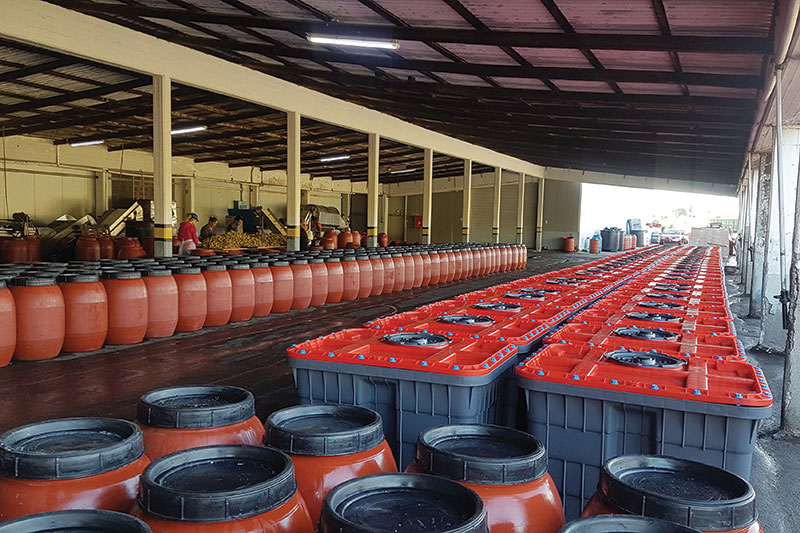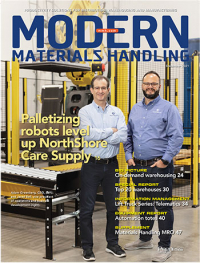Bulk containers meet sustainability
There’s not a lot of room for error when shipping olives 100 gallons at a time. These bulk containers are even more impressive when their attention to sustainability is considered, too.
It seemed like such a simple request: Tell me what’s going on these days with bulk containers.
But before Orbis’ market development director Bob Klimko said more than a few sentences about them, he talked a whole lot more about sustainability of these containers.
Actually, both parts turned out to be really interesting. But we’re going to deal with bulk containers here first. And I hope you stick around long enough to get to the sustainability part of this article. What Orbis is doing is really notable.
As to bulk containers. This is not a world most of us deal with daily. Instead, we buy attractively packaged glass jars of olives. We never see the 400-liter/102-gallon conical intermediate bulk container (IBC) that got the olives to the packaging plant in the first place.
Beyond food and beverage, says Klimko, these bulk containers are used by pharma and to ship powder solids and liquids. In fact, these IBCs are one of very few that have United Nations certification for shipping powders and liquids.
This is important because transporting liquids and bulk powders is not an easy thing. UN certification means that the product has been tested using rigorous standards to ensure the safety of the product, its contents, and the people who interface with the product during transport.
Klimko explains that design is so important for these containers. First of all, making them air tight and water tight is no easy feat. But there’s also the matter of designing them for maximum efficiency in shipping and returns (they do typically come back empty).
On the outbound side of the supply chain, the containers need to be sized to cube out 20- and 40-foot twenty-foot equivalent units. On the return side, they need to be nestable and stackable to a 6:1 return ratio. Furthermore, nestable and stackable saves up to 75% of storage space at any point in the supply chain.
In other words, life cycle of the containers is key to their success and sustainability. And that’s where Klimko kicks into high gear.
Turns out Orbis has a detailed program to help companies “analyze their supply chain for opportunities to drive sustainability, operational efficiency and cost savings.” Just as Klimko promised early in the interview this does all tie together with bulk containers and beyond.
He identifies the five steps Orbis follows here: Analyze, Prove, Design, Implement and Evolve. You can get the full details on these five at orbiscorporation.com. But here’s the short course.
Analyze the entire operation and supply chain.
Prove out the concept with a comprehensive reusable packaging program that optimizes the supply chain based on its specific needs.
Design the packaging to accommodate all measurable efficiencies from safety and cleanliness to warehouse utilization, greenhouse gas emissions as well as solid waste and energy usage.
Implement the specific package and integrate it into the supply chain.
Evolve more innovative packaging as needed over time.
What’s really notable about this is not just how comprehensive it is, but it translates a fairly soft word—sustainability—into the supply chain realities. That’s no easy feat and worth taking a close look at. So glad Klimko wanted to cover both topics.

Article Topics
Packaging News & Resources
Registration open for Pack Expo International 2024 Pack Expo East has largest show to date The Paccurate Report How AI just made label placement better Record-breaking Pack Expo Las Vegas exceeds expectations Optimal Parcel Packing For Cost Automated packaging makes noise at Crutchfield More PackagingLatest in Materials Handling
Beckhoff USA opens new office in Austin, Texas Manhattan Associates selects TeamViewer as partner for warehouse vision picking ASME Foundation wins grant for technical workforce development The (Not So) Secret Weapons: How Key Cabinets and Asset Management Lockers Are Changing Supply Chain Operations MODEX C-Suite Interview with Harold Vanasse: The perfect blend of automation and sustainability Consultant and industry leader John M. Hill passes on at age 86 Registration open for Pack Expo International 2024 More Materials HandlingAbout the Author
Subscribe to Materials Handling Magazine

Find out what the world's most innovative companies are doing to improve productivity in their plants and distribution centers.
Start your FREE subscription today.
April 2024 Modern Materials Handling

Latest Resources












